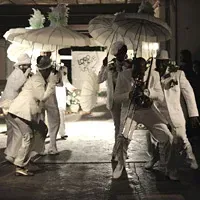'Katrina' by Jericho House
Written by

By James Hadley in London
Jericho House is a theatre company specialising in 'groundbreaking alliances between theatre, music and installation art'.
That statement had me interested straight away, as the most interesting work happening in London is, in my opinion, happening in those crossover areas between artforms, and in non-traditional spaces where the contract between audience and theatre experience can be rewritten anew.
Katrina is the new production by the company, recently staged in a warehouse space on London's South Bank, just down the block from the National Theatre. The publicity described it as a promenade staging, but to my mind it was more a traditionally staged play with installation elements added on before and after the text - a sandwich which worked remarkably well. The work is a dramatic account of the experiences of survivors of Hurricane Katrina in New Orleans, using verbatim accounts drawn from interviews.
Prior to experiencing these accounts, we wandered through several rooms in the warehouse that had been decorated as performance installations setting the scene of New Orleans as Katrina approached : a tourist office; the apartment of an African-American woman sitting knitting in a rocking chair; a cafe; and then a bar where a barman was serving drinks, a waitress mingling with the audience, and a singer started belting out a funk-soul number. This all proved an effective establishing shot for the play that was to follow, particularly when the TV monitors showing the approaching storm started flickering, along with the lights, sound effects gave the impression of a storm battering the outside of the bar, and then the power cut out.
We were led up to the next floor of the warehouse, where a large rectangular room had been evocatively dressed to conjure up the chaos of domestic debris left in the wake of the hurricane. The audience were sat on mismatched and distressed chairs along the long side of the space from which we watched the scripted verbatim play. Most affecting within this was the account of the woman we'd earlier seen in her apartment. Her de facto partner had been in the hospital on a life support machine when the hurricane hit, and died when the power cut. When no-one else was going to look after his body, she decided she couldn't just leave it and made a raft of a door on which she floated it across town in the flood waters.
Another account was of an ex-convict, finding a sense of purpose in his ability to come to the aid of his neighbours during the disaster. Another was of one of the prisoners left in their cell to drown, and then held at gunpoint without food by the prison guards when they escaped. The singer from the bar came forward with a story of the horrors she and her young daughter found when they sought refuge at the superdome stadium.
The fact that all these stories were of African-American characters highlighted the appauling facts that the world had been onlookers to: the white and well-off citizens had evacuated, leaving those with limited means to deal with the disaster as best they could - and the poor of the city were disproportionately non-white. So it felt a bit of an intrusion into the story when two white characters stood up out of the audience to tell the plight of tourists stranded in New Orleans when Katrina hit. But these stories were equally shameful examples of man's inhumanity to man when general chaos seems to justify rule by force.
I was astounded by just how horrific these survivors' testaments were - it was the human insensitivity with which those in authority handled aspects of survivors' needs that was so terrible. It was like hearing of the traumas of war. Because news reports only gave a general story, these individual testaments are a valuable reminder of how thin the veneer of civilisation can sometimes be. This value justified what might otherwise not have been the most dramatically compelling performance. Naturally, much of verbatim theatre is reportage, and the talking-heads direct address can sometimes flatten out the experience of drama actually located onstage.
So the framing promenade elements of the production were valuable for bringing the drama of the tragedy alive on another level. Once the scripted performance had finished, we were led out of the room and through rooms which were presumably directly above those we'd earlier walked through, but shown after the hurricane had been through. The woman's apartment that we'd initially seen her knitting in was now like a riverbed of mud, strewn with flotsam and jetsam - only the odd recognisable feature here and there to know it was the same room. What a great way of making the devastation of the hurricane something we could relate to on the individual level of this character's home and belongings.
Then it was up another floor into the attic of the building, where a stunning gospel vocalist led a funeral procession for the woman's de facto partner who'd died at the start of the play. All the characters, dressed in white, joined together in a jubilant musical celebration of this man's life which had necessarily been delayed due to the disaster, giving a sense of healing and respectful commemoration to the work as a whole.
If you're interested in the company's work, their previous production Fallujah can be watched online in its entirety via the company's website.